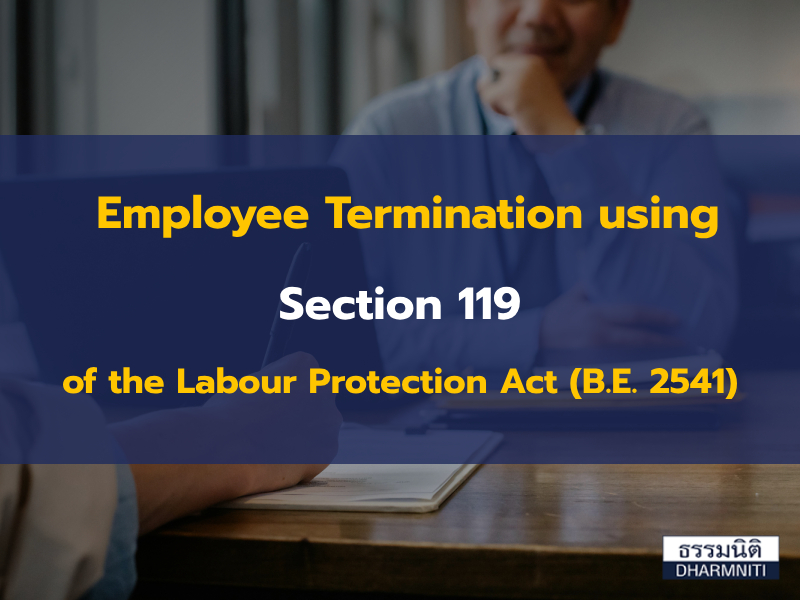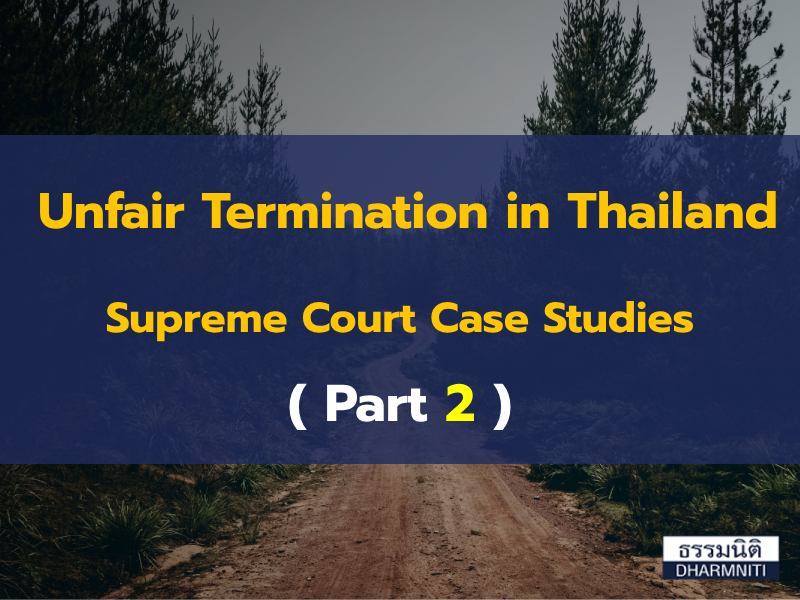Difference Between Severance Pay & Special Severance Pay
In this article, we shall examine the differences between normal severance pay and special severance pay under the Labour Protection Act (LPA).
In relation to normal severance pay which is dealt with under section 118 of the LPA, generally speaking it is payable to employees who are terminated without cause who have worked for their employer for more than 120 days and is payable according to the employee’s length of service with their employer. However, special severance pay is different in that it applies to other situations, these are as follows:
1. Where an employer relocates its place of business and the relocation materially affects the ordinary course of living of the employee or his/her family and the employee chooses not to stay with the employer they can terminate the employment contract and be eligible for special severance pay which shall be not less than the rate of severance pay they would be entitled to under Section 118 of the LPA. There are also advance notice requirements which must be met by the employer (i.e. must notify staff at least 30 days prior to relocation) and if this advance notice requirement is not complied with by the employer then an additional 30 days of salary (special severance pay) must be paid in lieu of the required advance notice. This is covered under s.120 of the LPA.
2. Staff being terminated because of improvements being made to the working unit, production, distribution or service processes, due to the utilization of machinery or change of machinery or technology. This type of termination is covered under sections 121 and 122 of the LPA; and
Special Severance Pay Due to Employer Relocation (s.120)
According to section 120 of the LPA where an employer relocates their workplace to another place and the relocation significantly affects the ordinary way of living of an employee or his/her family, the employer must inform the employee in advance of not less than thirty (30) days before the date of relocation. For this purpose, if any employee refuses to work at the new location, the employee is entitled to terminate a contract of employment within thirty (30) days from the date of being informed by the Employer or the date of relocation as the case may be. In this regard, the employee is entitled to a special severance pay of not less than the rate of severance pay for which he/she is eligible under section 118 of the LPA.
However, where the Employer fails to inform an employee in advance as specified above, the Employer must pay a special severance pay in lieu of advance notice in an amount equivalent to thirty (30) days’ pay at the latest wages rate, or equivalent to the wages of the last thirty (30) days for the employee who receives wages based on a piece rate.
It is also worth noting that the employer must pay special severance pay or special severance pay in lieu of advance notice to the employee within seven (7) days from the date when the employee terminates the contract.
Special Severance Pay due to improvements being made to the working unit, production, distribution or service processes, due to the utilization of machinery or change of machinery or technology (sections 121 and 122 of LPA)
If an employee is terminated for this reason, then the following shall apply:
A. Notice Requirement – The employer must notify the Labour Inspector and the employees to be terminated of the date of employment termination, the reasons for employment termination, and list of names of the employees at least sixty (60) days in advance of the employment termination date. The normal notice period as required under s.17 paragraph two of the LPA does not apply to this type of termination.
B. Pay in Lieu of Notice (depends if correct advance notice given or not) – If an employer fails to give advance notice to an employee of his/her termination, or gives advance notice but shorter than the period of time specified in paragraph one under s.121 (i.e. 60 days), in addition to the severance pay payable to the employee pursuant to s. 118, the employer shall in lieu of the advance notice, also pay special severance pay in an amount equal to sixty (60) days wage at the most recent wage rate received by the employee or equal to the wage for work performed in the last sixty days as an employee who is paid on the basis of his/her work output units.
C. Special Severance for Staff who have worked uninterrupted for six (6) years or more – Where an employer terminates an employee under section 121 and that employee has worked consecutively for six (6) years or more, the employer must pay special severance pay in addition to the severance pay under section 118, in an amount not less than the wage received at the most recent rate for fifteen (15) days, for each complete year of work (exceeding 6 years); or not less than the wage received at the most recent rate for fifteen (15) days for each complete year of work in as an employee who is paid on the basis of his/her work output units, BUT the total severance pay under this Section, in total, shall not exceed the amount of the wage at the most recent wage rate for three hundred and sixty (360) days or not exceed the wage for the last three hundred and sixty (360) days as an employee who is paid on the basis of his/her work output units. For the purpose of calculating special severance pay, where an employment period is less than one year but the fraction thereof is greater than one hundred and sixty (160) days, it shall be deemed to be one year of employment.
Example:
If an employer terminates an employee who has worked with them for 2.5 years due to the redundancy based on factors covered under point 2 above (such as technological improvements) then the following should apply:
1. Severance pay of 90 days of the employee’s last salary/wage rate – required under s.118(2) of the LPA (given that employee has worked for more than 1 year but less than 3 years);
2. In relation to advance notice for a termination for this reason, s.121 stipulates that the employer must notify the Labour Inspector and the employee(s) to be terminated, of the date of employment termination, reasons for employment termination, and list of names of the employees at least sixty (60) days in advance of the employment termination date. If they fail to comply with this notice requirement then they must pay the employee in lieu of this notice requirement special severance pay in an amount equal to sixty (60) days wages at the most recent wage rate received by the employee. Hence, the money in lieu will only apply if the advance notice requirement of 60 days to the Labour Inspector and the employees is not complied with.
3. In relation to special severance pay under s.122 of the LPA, it would not be payable by the employer in this case because the employee has not worked for an uninterrupted period of 6 years, they have only worked for 2.5 years. However, if an employee had worked for their employer on an uninterrupted basis for 17 years and 195 days and they are terminated under s.121 (due to working unit improvements) then they will be entitled to special severance pay under s.122 of: 12 x 15 days last salary/wage rate.
Dharmniti Law Office Co., Ltd.
2/2 Bhakdi Building 2nd Floor, Witthayu Road, Lumphini, Pathumwan, Bangkok 10330
Tel: (66) 2680 9777 Fax: (66) 2680 9711
Email: ryan@dlo.co.th or info@dlo.co.th
Writer: Ryan Crowley- Foreign Services Manager




 Except where otherwise indicated, content on this site is allowed to be used under
Except where otherwise indicated, content on this site is allowed to be used under